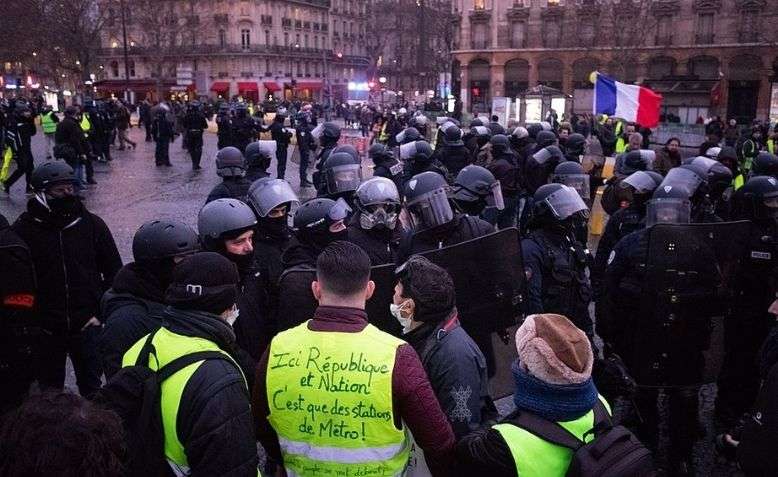 Paris, place de la Bastille, 26th Jan 2019. Photo: Olivier Ortelpa / Gilets Jaunes, acte XI / Wikimedia Commons / cropped original image / licensed under CC 2.0, linked at bottom of article
Paris, place de la Bastille, 26th Jan 2019. Photo: Olivier Ortelpa / Gilets Jaunes, acte XI / Wikimedia Commons / cropped original image / licensed under CC 2.0, linked at bottom of article
The experiences of the Gilets jaunes have much to tell us about the capitalist state’s response to mass protest, writes Susan Ram
For people across France, the latest images and footage of British police in action against ‘upstart’ demonstrators must be ringing a cacophony of bells.
Two years ago, hundreds of thousands of French citizens donned yellow safety vests, took to the streets, blocked roads, and set up camp on roundabouts as part of a nationwide uprising against the Macron government were finding themselves at the sharp end of similarly brutal state response.
A stream of shocking social media videos showed the French variants of the ‘boys in blue’ – a lethal cocktail of police and security operatives, unidentifiable behind their riot helmets and layers of body armour – unleashing what amounted to a war on their fellow citizens.
No question here of ‘proportional’ responses or nuanced assessment of specific situations. Battle-primed police simply let rip, deploying not just the batons, tear gas, and water jets of old but also a panoply of ‘non-lethal’ high-velocity weapons: stun grenades which explode on touch, and ‘flashball’ launchers which propel rubber projectiles at intense velocity into flesh and eye socket.
The result was a grisly tally of injured, maimed and blinded protestors (and in some cases passers-by.) There were also deaths: one of the first fatalities was Zineb Redouane, an 80-year-old woman of Algerian origin who died in December 2018 after being hit in the face by a police grenade during a security operation against a Yellow Vest protest in Marseille (Zineb was hit while closing her apartment window).
In February 2019 in Paris, a 30-year-old Yellow Vest taking photos of protests outside the National Assembly (the French parliament) had his hand blown off by a delayed reaction grenade containing 25 gm of TNT. The previous month, Jerome Fernandes, a much-respected pacifist spokesman for the movement, was blinded in his right eye following a targeted attack.
The extreme violence deployed by the French state via its police and security operatives in an effort to bring the Yellow Vests to heel would shake large sections of public opinion while triggering alarm bells among jurists, defenders of civil liberties and international human rights organisations.
Among those stirred to action was the writer and filmmaker David Dufresne, who launched an initiative to record every instance of police-inflicted injury. His subsequent documentary film, ‘Un pays qui se tient sage’ (translated into English as ‘The Monopoly of Violence’) provides graphic evidence of the rigour with which the contemporary French state sets about maintaining ‘law and order’.
As the French writer and researcher Mathieu Rigouste notes in a useful article, the Yellow Vests represent just one element in a long stream of ‘adversaries’ against whom the shock troops of the French state have waged war over the decades.
Highlighting the degree to which modern-day French police “are shaped by the violence of their history”, Rigouste reminds us not only of the connections between state violence at home and abroad but also of its class and racialised dimensions:
“Many [police] methods of surveillance and repression found their way to the homeland from the repertoire of forces in charge of “indigenous North Africans” in former French colonies. Throughout the colonial period, police agents and officers took their experience from places such as Algeria and applied them to the policing of working-class neighbourhoods and the quelling of insurrections in mainland France.”
But if the direct experience of French police violence was once confined to the ‘lower orders’, the marginalised and the voiceless, all has changed in a context governed not simply by the eruption of social media but also by the widening of the war to include hitherto unaffected sections of the population.
It’s worth remembering that many of those mobilised by the Yellow Vest movement were novice protestors: people from the ‘mainstream’ who had never before taken to the streets. Where once the state and its mass media echo chambers could dismiss charges of excessive force by describing victims as “repeat offenders” or “drug abusers” responsible for the violence they had suffered, the routinely brutal, racist character of French policing has now been exposed for all to see.
Rigouste offers us this timely reminder:
“Whether they face demonstrators or banlieue youth, police officers perpetrate the forms of violence that the upper classes deem necessary to prop up an increasingly unequal social order. Police violence is not the result of the French state losing control: it is a long-established technique of government.”
The Yellow Vests should be a stark reminder to those commenting on the protests in Bristol that any so-called violence on the part of protesters is not comparable to the wrath of the state. It is also a reminder that to stop the attacks we must keep protesting and continue to fight back.
Before you go
Counterfire is growing faster than ever before
We need to raise £20,000 as we are having to expand operations. We are moving to a bigger, better central office, upping our print run and distribution, buying a new printer, new computers and employing more staff.

